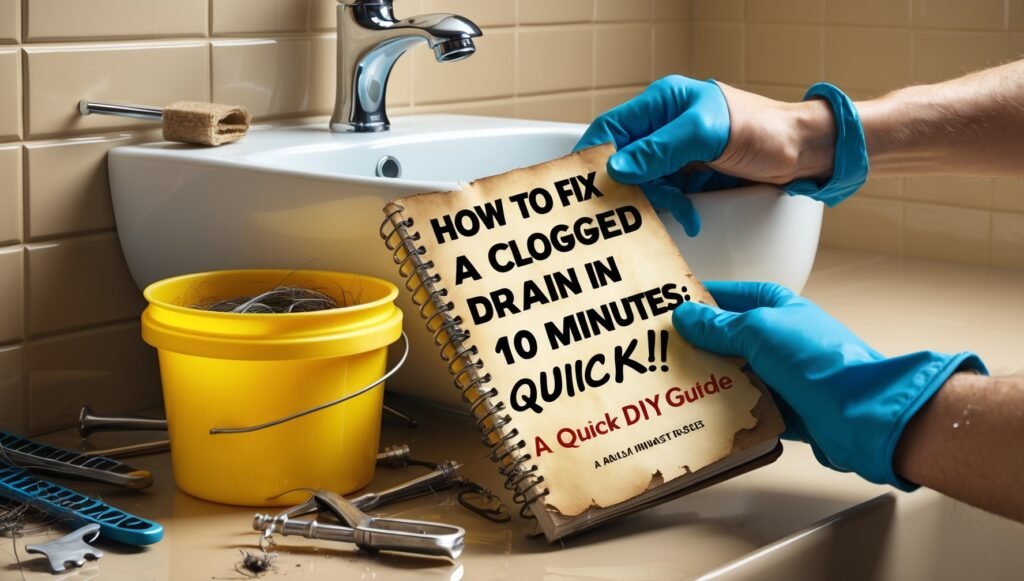
A clogged drain is one of the most common household plumbing problems. Whether it’s a kitchen sink, bathroom sink, or shower drain, a clog can disrupt your daily routine and cause frustration. Fortunately, fixing a clogged drain doesn’t have to be difficult or expensive. In fact, with the right tools and techniques, you can clear most clogs in as little as 10 minutes.
In this blog post, we’ll show you how to quickly and effectively fix a clogged drain using simple methods you can do yourself. Plus, we’ll share tips on how to prevent future clogs, so you can save time and money in the long run.

Why Do Drains Get Clogged?
Before jumping into the fix, it’s important to understand why drains clog. Clogs can happen for a variety of reasons, but the most common causes include:
Hair Buildup: In bathroom sinks and showers, hair often combines with soap and grime, forming a stubborn clog.
Grease and Food Debris: In kitchen sinks, food particles and grease can accumulate over time, blocking the drain.
Soap Scum: Soap can leave a residue in the pipes, which can attract other debris and lead to a clog.
Foreign Objects: Sometimes, small items like jewelry or toys can accidentally fall into the drain, causing a blockage.
What You’ll Need
To fix a clogged drain in 10 minutes, you’ll need a few basic tools and materials. Don’t worry; these are easy to find and inexpensive to purchase:
Plunger–To dislodge the clog in the drain.
Baking Soda and Vinegar – A natural solution for dissolving minor clogs.
Drain Snake – For reaching deeper clogs that a plunger can’t remove.
Rubber Gloves – To protect your hands from germs and debris.
Bucket – To catch any water or debris that may spill out.
Recommended Amazon Products:
Plunger: Check it out on Amazon
Drain Snake: Buy it here on Amazon
Step-by-Step Guide: How to Fix a Clogged Drain in 10 Minutes
Step 1: Assess the Situation
First, determine the severity of the clog. If the water is draining slowly but still moving, it’s likely a minor clog. However, if the water is completely backed up and stagnant, you might need a more powerful method to clear the drain. In either case, these steps should help.

Step 2: Use a Plunger
The plunger is one of the simplest and most effective tools for clearing a clogged drain. To use a plunger:
Make sure the drain is covered with water. If not, add some water to the sink or tub.
Place the plunger over the drain, ensuring that it creates a tight seal.
Push down firmly, then pull up sharply. Repeat this motion for 10-15 seconds.
Check if the water drains. If it does, congratulations! You’ve successfully cleared the clog.
Tip: use a plunger designed for sinks or tubs, as these have a wider rubber base that can create a better seal.
Step 3: Try the Baking Soda and Vinegar Method
If the plunger didn’t work or if you prefer a more natural solution, try using baking soda and vinegar. This is an eco-friendly and effective way to dissolve minor clogs. Here’s how to do it:
Pour 1 cup of baking soda down the drain.
Follow it with 1 cup of vinegar.
Plug the drain and let the mixture sit for 10-15 minutes. The baking soda and vinegar will react, creating a fizzing action that breaks down the clog.
After 15 minutes, run hot water down the drain to flush everything out.
This method works well for soap scum, grease buildup, and hair clogs. It’s also a great option if you want to avoid harsh chemicals.
Tip: Repeat this process once a month to keep your drains clean and prevent future clogs.
Step 4: Use a Drain Snake
If the clog is deeper in the pipes and cannot be removed by the plunger or baking soda method, a drain snake is your next best option. A drain snake is a long, flexible tool that can reach clogs located deep within the drain.
Here’s how to use a drain snake:
Insert the end of the snake into the drain, then turn the handle to feed the snake into the pipes.
When you feel resistance, you’ve likely reached the clog. Turn the snake in a clockwise motion to break up the clog.
After dislodging the clog, drag out the snake, continuing to twist.
Run hot water down the drain to clear out any remaining debris.
Tip: Be patient, as it may take a few tries to fully break up the clog, especially if it’s in a hard-to-reach area.

Step 5: Prevent Future Clogs
Now that your drain is clear, it’s important to prevent future clogs from forming. Here are a few tips:
Avoid putting grease down the drain: Grease solidifies in the pipes, creating a sticky residue that traps food particles and causes clogs.
Use a drain strainer: A simple drain strainer can catch hair, food particles, and other debris before they go down the drain.
Regularly clean your drains: Perform the baking soda and vinegar method once a month to keep your pipes clear.
Dispose of food properly: Always throw food scraps in the trash rather than down the drain.
Finally
Fixing a clogged drain is a quick and easy task that can be done in under 10 minutes with the right tools and techniques. Whether you use a plunger, a natural solution like baking soda and vinegar, or a drain snake, these methods will help you keep your drains flowing smoothly and prevent future clogs.
If you want to learn more about DIY home repairs and maintenance, be sure to check out our premium DIY books:
A Friendly Guide To DIY Confidence: A DIY Prevention and Repair Handbook Find it here
DIY Story Book for Beginners Get your copy here
Don’t let clogged drains disrupt your day—use these simple tips to keep your plumbing in great condition!
FixItSmartly.com helps everyday people save money and build confidence by tackling home and car repairs with easy, practical DIY solutions. Live smart, safe, and self-reliant — one fix at a time.
Copyright © 2025 Fixitsmartly